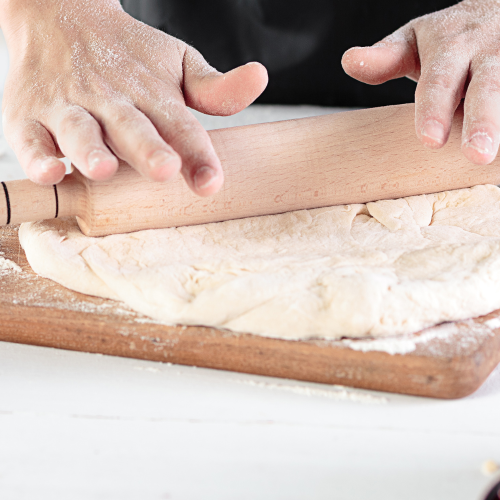Step-by-Step Method
Prepare the Dough
In a small bowl, dissolve the yeast in 50 ml of cold water. Let it sit for 5–10 minutes until foamy.
In a large mixing bowl, combine the flour and salt. Slowly incorporate the yeast mixture and the remaining cold water.
Mix until a shaggy dough forms, then add the olive oil. Knead by hand or with a stand mixer for about 10 minutes until the dough is smooth and elastic.
First Proofing
Lightly coat a clean bowl with olive oil and place the dough inside. Cover it with a damp kitchen towel or plastic wrap. Let it rest at room temperature for 1–2 hours until it doubles in size.
Cold Fermentation
Once proofed, gently deflate the dough and divide it into 6 equal portions. Shape each portion into a ball and place them on a floured tray. Cover tightly with plastic wrap.
Refrigerate for 24–48 hours to allow the dough to develop its unique flavor and airy structure.
Shaping the Dough
Remove the dough balls from the fridge 1–2 hours before baking to bring them to room temperature.
On a floured surface, gently stretch or roll each dough ball into a thin circle (about 10–12 inches in diameter).
Cooking the Pizza
Preheat your oven to its maximum temperature (250–280°C/480–550°F) and place a pizza stone inside to heat for at least 30 minutes.
Dust a pizza peel with semolina flour and transfer the shaped dough onto it. Add desired toppings, keeping it light to maintain the crisp crust.
Slide the pizza onto the hot stone and bake for 8–10 minutes or until golden and crisp.
Variations and Tips
For Whole Wheat Dough: Replace 100 g of "00" flour with whole wheat flour for a nuttier flavor.
Gluten-Free Option: Use a 1:1 gluten-free flour blend, but expect a less elastic dough.
For a Softer Crust: Increase the hydration by adding 25 ml more water.
Toppings: Classic Roman toppings include tomato sauce, mozzarella, and fresh basil (Margherita), or try olive oil, rosemary, and sea salt (Pizza Bianca).
